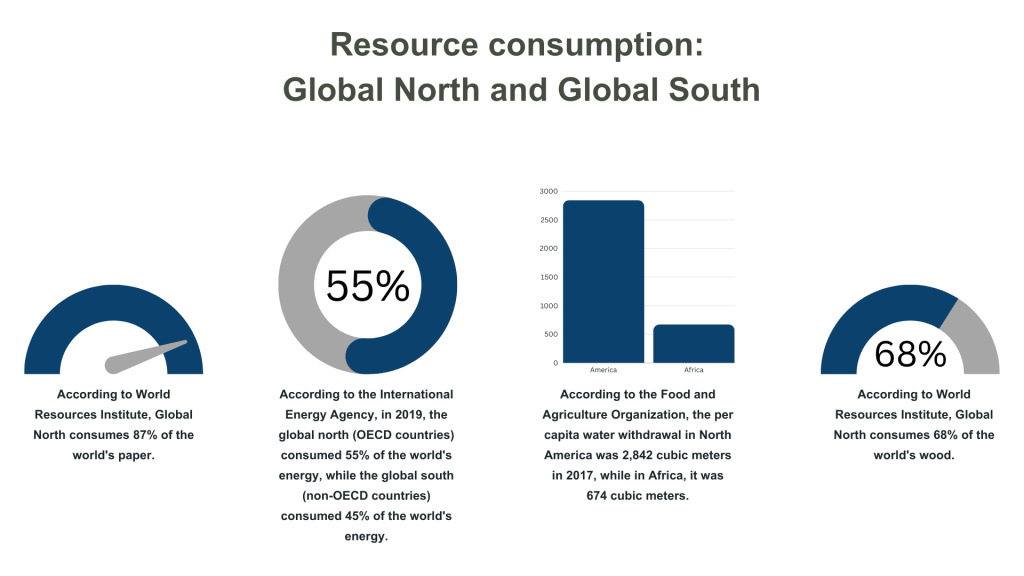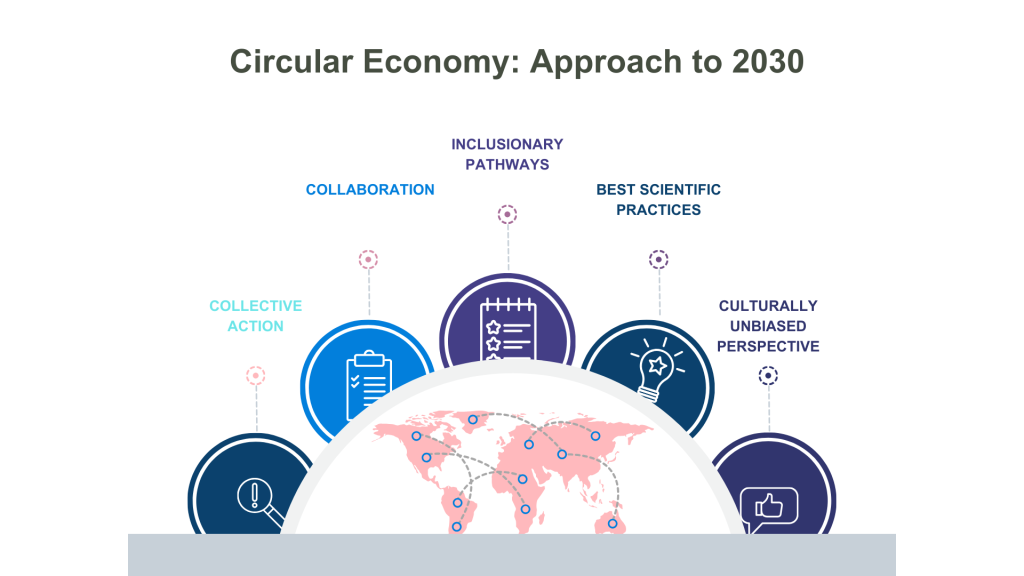Global South
The term “Global South” refers to countries located primarily in the Southern Hemisphere, often characterized by shared socio-economic and developmental challenges. It’s a contemporary way of referring to what was once called “Third World” or “developing” countries. Still, these older terms have fallen out of favor due to their pejorative and oversimplified connotations.

The “Global South” is not a strict geographic designation. Instead, it’s a socio-economic and political categorization. The Global South is characterized by economic disparities when compared to the more developed nations of the Global North. These countries often face challenges related to poverty, underdevelopment, and, in some cases, external debt. Besides economic issues, countries of the Global South grapple with challenges such as health care access, education, sanitation, and infrastructure development. Many countries in the Global South have a shared history of colonization by European powers, which have had long-term impacts on their socio-economic structures.
It’s crucial to recognize the vast diversity within the Global South. The category includes countries from Africa, Latin America, and Asia each with its unique history, culture, and challenges. While historically lagging behind the Global North in terms of economic development, many countries in the Global South are now experiencing rapid growth and development. As a result, the lines between North and South are becoming less distinct in some areas.

Global geopolitical landscape
The global geopolitical landscape has been evolving rapidly over the last few years, influenced by changing power dynamics, technological advancements, global challenges like climate change and pandemics, and shifts in the global economic order. In this intricate puzzle, India has emerged as a significant player, carving out a unique role for itself.
India’s role in building a new paradigm
1. Economic Growth: With its expanding economy, India is increasingly being viewed as an engine for global growth. While the economies of many developed countries are maturing, India’s demographic dividend, with a young and aspirational population, is driving consumption and innovation.
2. Strategic Location: Geographically, India’s position between the Middle East and Southeast Asia gives it a strategic advantage. It acts as a bridge in the Indo-Pacific region, a region that has become central to global geopolitics.
3. Diplomatic Initiatives: India’s diplomacy has evolved from non-alignment during the Cold War to what is often termed as ‘multi-alignment’ today. India maintains relationships with major powers such as the U.S., Russia, and European nations, while also fostering ties with its Asian neighbors and African nations.
The New Delhi Leaders’ Declaration at G20:
India’s role in the changing geopolitical scenario is marked by its attempt to balance its interests with global responsibilities. The New Delhi Declaration at the G20 serves as an example of India’s growing influence and its aspirations to contribute positively to global governance and stability. The New Delhi Declaration was a significant milestone in projecting India’s leadership role on the global stage.
- Commitment to Multilateralism: Through the declaration, India underscored the importance of strengthening multilateral institutions. This comes at a time when there are growing concerns about unilateralism and protectionism in various parts of the world.
- Sustainable Development: The declaration emphasized India’s commitment to the United Nations’ Sustainable Development Goals (SDGs). By championing these goals, India is highlighting its role in global initiatives for a sustainable future.
- Climate Change: India’s focus on renewable energy and sustainable practices was evident in the declaration. As one of the world’s largest consumers of energy, India’s role in combating climate change is pivotal.
- Promoting a Fair Global Economic System: The declaration also pointed towards the need for reforms in global economic institutions to make them more representative and fairer. This can be seen as India’s call for a more equitable global order.
- Inclusive Growth: The New Delhi Declaration emphasized the importance of inclusive growth, indicating India’s stand on bridging economic disparities both within and among nations.
As India continues to rise in stature, its actions and decisions will significantly influence the geopolitical dynamics.
Inclusion of Circular Economy
Para 34 of New Delhi Declarations states that “We reiterate our commitment to achieve global net zero GHG emissions/carbon neutrality by or around mid-century, while taking into account the latest scientific developments and in line with different national circumstances, taking into account different approaches including the Circular Carbon Economy, socioeconomic, technological, and market development, and promoting the most efficient solutions.”
Para 37 of the declaration highlights India’s efforts to decouple economic growth from environmental degradation and enhance sustainable consumption and production, including primary resource consumption while supporting economic growth. It states that “we acknowledge the critical role played by the circular economy, extended producer responsibility and resource efficiency in achieving sustainable development. We thank the Indian presidency in launching the Resource Efficiency and Circular Economy Industry Coalition (RECEIC). We commit to enhance environmentally sound waste management, substantially reduce waste generation by 2030, and highlight the importance of zero waste initiatives.”


Mission LiFE and Circular Economy
During its G20 presidency, India highlighted the need for high-level principles on lifestyles for Sustainable Development. This includes-
- Respectful, responsible conservation, sustainable use, and regeneration of natural resources is at the heart of environmentally conscious lifestyles as well as consumer choices – One Earth
- Requires collective and coherent actions, collaboration, and coordination amongst stakeholders at all levels, including individuals, communities, academia, media, civil society, government, international organizations, private sector, and industry to combat land degradation and desertification, halt and reverse biodiversity loss by 2030, reduce environmental pollution, and achieve global net zero greenhouse gas emissions by or around mid-century, through low GHG emissions/low-carbon, climate resilient and environmentally sustainable development pathways, taking into account different national circumstances, and capacities – One Family
- Integrated approach for achieving our shared goals on development, environment, and climate with human beings at the center of our actions, leaving no one behind – One Future
Mission Life stands as an emblematic initiative by the Hon’ble PM of India, Mr Narendra Modi, which aims to redefine the relationship between consumption and economic prosperity. Traditionally, economic growth has been tethered to escalating consumption, often leading to excessive resource extraction and environmental degradation. However, Mission Life advocates for a decoupling of consumption from economic growth, emphasizing sustainability, recycling, and the reuse of resources. By championing a transition from a linear to a circular model, Mission Life promotes an economy where products are designed for longevity, waste is minimized, and resources are continually recycled and repurposed. This paradigm shift ensures that economic prosperity doesn’t come at the expense of our planet. In essence, Mission Life is not just a strategy but a philosophy, propelling societies toward sustainable growth while respecting the environmental thresholds of our planet.
Role India can play in enabling global circular transition
India, with its unique combination of geopolitical significance, age-old sustainable practices, and dynamic diplomatic engagements, can play a pivotal role in facilitating a global circular transition.
As the world’s largest democracy and one of its most populous nations, India’s policies and initiatives carry significant weight. India’s historic ties with countries in the Global South, cemented through platforms like the Non-Aligned Movement, BRICS, and vaccine diplomacy during the pandemic give it a unique standing. We can leverage these relationships to promote the circular economy model, emphasizing mutual benefits in terms of sustainable growth, job creation, and environmental preservation. The recent efforts to foster relationships through several initiatives with African, Southeast Asian and Latin American countries show our commitment to strengthening ties with the Global South. These engagements can serve as platforms for knowledge sharing, technological collaboration, and financial mechanisms that support circular economy transitions.
Historically, India’s consumption patterns have been rooted in sustainability, with practices like reusing materials, repairing old items, and minimizing waste deeply embedded in daily life. These traditional practices, when combined with modern technology and innovation, can offer scalable solutions for a circular economy. Concepts like “Vasudhaiva Kutumbakam” (the world is one family) and reverence for nature are intrinsic to Indian philosophy. These principles promote a holistic view of sustainability, where economic, environmental, and societal well-being are interlinked. By emphasizing these cultural values at the international platforms, India can inspire a deeper understanding and appreciation for the circular economy beyond mere economic or environmental considerations.
The remarkable success of the G20 places India in a prime position to champion the global circular transition. By setting domestic examples and forging international collaborations on knowledge exchange, technology transfer, and financial support, India can be both a beacon and a bridge for countries navigating their circular economy pathways.
Way forward- India as a global guru!
India can play a crucial role in providing momentum towards achieving global development, environmental, and climate goals while respecting the diverse national circumstances and capabilities of countries, especially the developing ones.

India’s dual identity as a developing economy with global influence positions it uniquely to provide an impetus for a balanced approach to development, environment, and climate goals. It’s the right time to advocate actions that can resonate with developing countries, making it a significant player in shaping the global agenda. India, as one of the world’s most populous countries and major economies, can lead by example in achieving development and environmental goals. For instance, India’s ambitious target to achieve 450 GW of renewable energy by 2030 showcases its commitment to sustainable energy.
South-South Cooperation:
India has always been a strong proponent of South-South cooperation, fostering collaboration among developing countries. By sharing best practices, technologies, and lessons learned, India can help countries in the Global South navigate their unique challenges in achieving circular carbon economy, support and accelerate their efforts to prioritize adaptation and mitigation actions, including sustainable consumption and production for tackling climate change, combating land degradation and desertification, halting and reversing biodiversity loss, reducing environmental pollution, promoting sustainable production and industrialization with low GHG emissions and lifting people out of poverty while aiming to leave no one behind.
Bridging North-South Divide:
India’s position allows it to bridge the traditional North-South divide. Through forums like BRICS, the India-EU Summit, India can advocate for equity and fairness in global agreements, emphasizing the principle of “common but differentiated responsibilities.” India can partner with other nations to create or strengthen financing mechanisms that support sustainable development in developing countries. More initiatives like the International Solar Alliance (ISA), and Global Biofuel Alliance (GBA) should focus on assisting developing countries.
Technical and Capacity Building Assistance:
India can extend its expertise in areas like information technology, renewable energy, sustainable agriculture, and water conservation to other developing nations. More programs through specialized institutions could help provide training to professionals from developing countries. India has a rich reservoir of traditional knowledge related to sustainable farming, water conservation, forest management, and biodiversity. By sharing this wisdom, India can offer alternative development paradigms that are ecologically sensitive.
Time to ACT is now
India is poised to act as a global guru for several reasons, based on its historical heritage, growing international influence, and recent achievements. We possess one of the world’s youngest populations. This demographic dividend can be harnessed for global leadership in areas ranging from technology to culture. Even amidst global economic challenges, India’s economy has shown resilience and growth potential. By 2025, we shall be the third-largest economy in the world. Our digital transformation journey, exemplified by initiatives like Aadhaar (the world’s largest biometric ID system) and UPI (Unified Payments Interface), sets it apart in digital innovation. ISRO’s successful missions, such as the Mars Orbiter Mission and Chandrayaan-3, demonstrate India’s capabilities in space technology. The global appeal of Indian culture, from yoga to Bollywood, offers India soft power influence. The International Day of Yoga, celebrated globally, is a testament to India’s cultural reach. Often referred to as the “pharmacy of the world,” India plays a crucial role in producing affordable medicines and vaccines. The country’s rapid response in producing and distributing COVID-19 vaccines, both domestically and internationally through the “Vaccine Maitri” initiative, underscores its vital role in global health. India’s commitment to renewable energy, particularly solar energy through the International Solar Alliance, portrays its proactive stance on tackling climate change. The National Education Policy (NEP) 2020 is a progressive step, emphasizing holistic, multidisciplinary education. It can serve as a model for developing nations aiming to overhaul their education systems.
With its ancient philosophy emphasizing universalism and interconnectedness, India offers a perspective that transcends narrow nationalistic interests, resonating with global challenges. India’s active engagement in international forums, from the United Nations to regional platforms like SAARC and ASEAN, showcases its dedication to multilateralism and global cooperation. Our efforts to promote regional security, through initiatives like the Quad and its active role in the Indian Ocean Region, showcase its commitment to maintaining regional and global peace.
Given the achievements of India in the past 9 years, it is well-positioned to act as the voice of the global south on issues like Climate Change, and Circular Economy. Our efforts should proactively contribute to global well-being and progress.

The Author of this article is a renowned Circular Economy specialist from India. She is the Managing Director of the International Council for Circular Economy.
